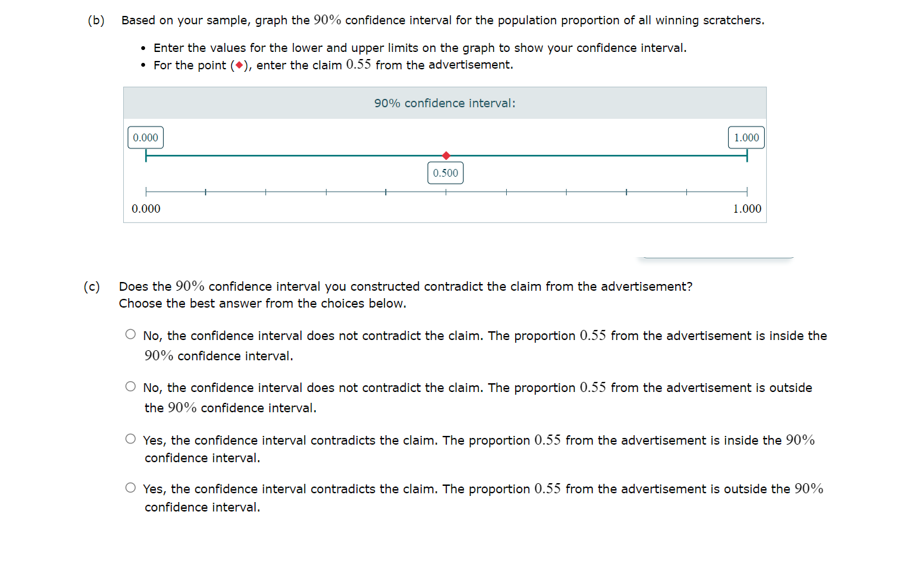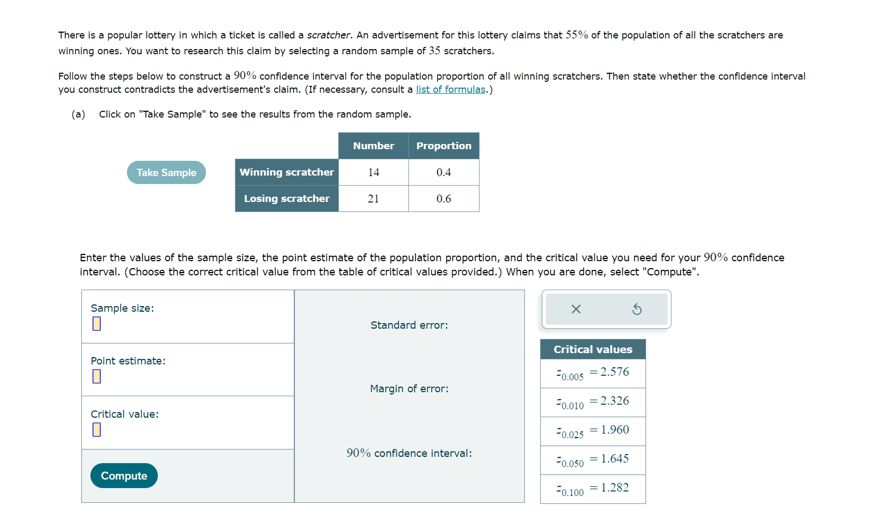There is a popular lottery in which a ticket is called a scratcher. An advertisement for this lottery claims that 55% of the population of all the scratchers are winning ones. You want to research this claim by selecting a random sample of 35 scratchers. Follow the steps below to construct a 90% confidence interval for the population proportion of all winning scratchers. Then state whether the confidence interval you construct contradicts the advertisement's claim. (If necessary, consult a list of formulas.) (a) Click on "Take Sample" to see the results from the random sample. Number Proportion Take Sample Winning scratcher Losing scratcher 14 0.4 21 0.6 Enter the values of the sample size, the point estimate of the population proportion, and the critical value you need for your 90% confidence interval. (Choose the correct critical value from the table of critical values provided.) When you are done, select "Compute". Sample size: 0 Point estimate: Critical value: Compute Standard error: Critical values F0.005 -2.576 Margin of error: F0.010 -2.326 -0.025 -1.960 90% confidence interval: F0.0501.645 F0.100 = 1.282
There is a popular lottery in which a ticket is called a scratcher. An advertisement for this lottery claims that 55% of the population of all the scratchers are winning ones. You want to research this claim by selecting a random sample of 35 scratchers. Follow the steps below to construct a 90% confidence interval for the population proportion of all winning scratchers. Then state whether the confidence interval you construct contradicts the advertisement's claim. (If necessary, consult a list of formulas.) (a) Click on "Take Sample" to see the results from the random sample. Number Proportion Take Sample Winning scratcher Losing scratcher 14 0.4 21 0.6 Enter the values of the sample size, the point estimate of the population proportion, and the critical value you need for your 90% confidence interval. (Choose the correct critical value from the table of critical values provided.) When you are done, select "Compute". Sample size: 0 Point estimate: Critical value: Compute Standard error: Critical values F0.005 -2.576 Margin of error: F0.010 -2.326 -0.025 -1.960 90% confidence interval: F0.0501.645 F0.100 = 1.282
Holt Mcdougal Larson Pre-algebra: Student Edition 2012
1st Edition
ISBN:9780547587776
Author:HOLT MCDOUGAL
Publisher:HOLT MCDOUGAL
Chapter11: Data Analysis And Probability
Section11.4: Collecting Data
Problem 2E
Related questions
Question

Transcribed Image Text:(b) Based on your sample, graph the 90% confidence interval for the population proportion of all winning scratchers.
•
Enter the values for the lower and upper limits on the graph to show your confidence interval.
For the point (*), enter the claim 0.55 from the advertisement.
0.000
0.000
90% confidence interval:
0.500
(c)
Does the 90% confidence interval you constructed contradict the claim from the advertisement?
Choose the best answer from the choices below.
1.000
1.000
○ No, the confidence interval does not contradict the claim. The proportion 0.55 from the advertisement is inside the
90% confidence interval.
No, the confidence interval does not contradict the claim. The proportion 0.55 from the advertisement is outside
the 90% confidence interval.
Yes, the confidence interval contradicts the claim. The proportion 0.55 from the advertisement is inside the 90%
confidence interval.
○ Yes, the confidence interval contradicts the claim. The proportion 0.55 from the advertisement is outside the 90%
confidence interval.

Transcribed Image Text:There is a popular lottery in which a ticket is called a scratcher. An advertisement for this lottery claims that 55% of the population of all the scratchers are
winning ones. You want to research this claim by selecting a random sample of 35 scratchers.
Follow the steps below to construct a 90% confidence interval for the population proportion of all winning scratchers. Then state whether the confidence interval
you construct contradicts the advertisement's claim. (If necessary, consult a list of formulas.)
(a) Click on "Take Sample" to see the results from the random sample.
Number
Proportion
Take Sample
Winning scratcher
Losing scratcher
14
0.4
21
0.6
Enter the values of the sample size, the point estimate of the population proportion, and the critical value you need for your 90% confidence
interval. (Choose the correct critical value from the table of critical values provided.) When you are done, select "Compute".
Sample size:
Point estimate:
Critical value:
Compute
Standard error:
G
Critical values
Margin of error:
-0.005 = 2.576
-0.010 -2.326
-0.025 -1.960
90% confidence interval:
-0.050 1.645
0.100 1.282
Expert Solution
This question has been solved!
Explore an expertly crafted, step-by-step solution for a thorough understanding of key concepts.
Step by step
Solved in 6 steps with 18 images

Recommended textbooks for you

Holt Mcdougal Larson Pre-algebra: Student Edition…
Algebra
ISBN:
9780547587776
Author:
HOLT MCDOUGAL
Publisher:
HOLT MCDOUGAL

College Algebra (MindTap Course List)
Algebra
ISBN:
9781305652231
Author:
R. David Gustafson, Jeff Hughes
Publisher:
Cengage Learning

Holt Mcdougal Larson Pre-algebra: Student Edition…
Algebra
ISBN:
9780547587776
Author:
HOLT MCDOUGAL
Publisher:
HOLT MCDOUGAL

College Algebra (MindTap Course List)
Algebra
ISBN:
9781305652231
Author:
R. David Gustafson, Jeff Hughes
Publisher:
Cengage Learning